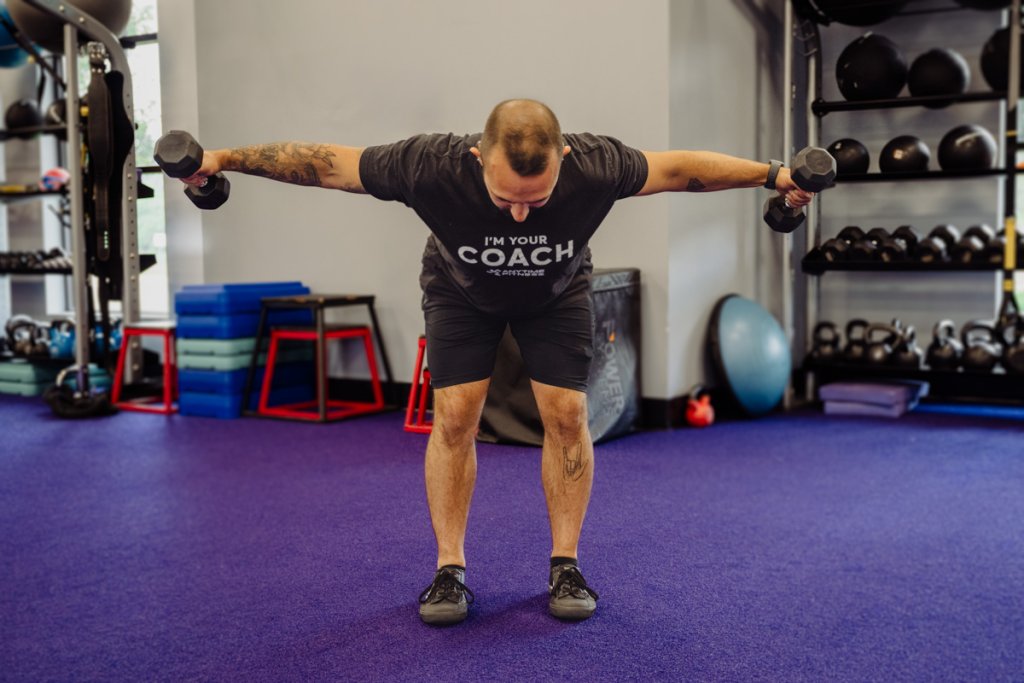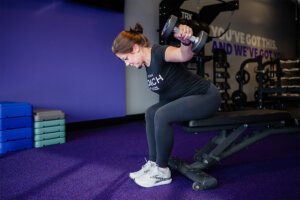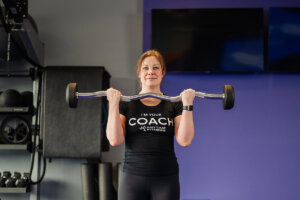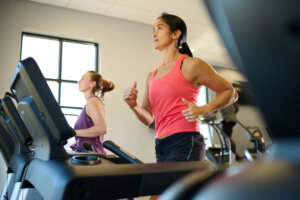The word “conditioning” can send many of us right back to running sprints in practice. If the terms “Gassers” or “Herbies” strike fear in your heart, you may not be psyched to incorporate another full-body conditioning workout into your routine. Totally fair.
But this is not your high school football coach’s conditioning program. Far from it. We’re breaking down everything you need to know about this kind of training and giving you a total body conditioning workout that works for all fitness levels (even if your idea of conditioning in high school had more to do with hair care than cardiovascular endurance).
What is a conditioning workout?
A conditioning workout program is more than just cardio. While it does build your endurance, it also involves building strength, speed, agility, and mobility. Similar to cardio, it improves heart and lung function, but a total-body conditioning workout takes things a step further by introducing movements and intensity that can allow you to work harder and perform better in your workouts, for longer periods of time.
To get the full benefit, you should incorporate conditioning training into your fitness routine 2–3 times per week. This could be strength training, HIIT training, circuits, or strictly cardio sessions. Don’t forget to incorporate rest into your training program, too. Rest is just as important for fitness because it allows your body to recover and sets you up for success during your next workout.
Who is a conditioning workout for?
Everyone. A common misconception is that conditioning workouts are intended to prepare athletes for sport-specific challenges, while cardio was for the rest of us. Sure, you can use it to level up your basketball game or crush your next round of disc golf, but total-body conditioning workouts are actually great for all fitness levels thanks to their functional benefits. If you’d like to not get winded when you climb a flight of stairs, a conditioning workout will help. Do you want to improve agility and stamina to take your workouts even further? Yep. Also, a conditioning workout.
Total-body conditioning workouts can take a variety of forms. It’s important to adjust based on your fitness level and goals. If you’re a beginner, start small and build up the intensity over time.
What are the benefits of a conditioning workout?
Conditioning exercises help build your power, coordination, and speed, and they don’t require much or any equipment — so you can do them anywhere. Other physical and mental benefits include:
- Help prevent injuries: Accidents can happen, but you’re more likely to make a huge mistake during exercise when you’re fatigued and are no longer focused on having proper form — especially when lifting heavy weights. By having a good foundation, you’re limiting the chances of injury to muscles, ligaments, tendons, and even joints and bones.
- Increased performance: Like we said, when your body is properly conditioned, it allows you to execute each movement with good form, resulting in more power and speed. More power and speed = better performance = better results.
- Boosted metabolism: Conditioning work is great exercise! Typically, the workouts are higher intensity, which means increased heart rate. When your heart rate spikes, so does your metabolism, which helps burn calories and fat.
- Time-saving: When you’re crunched for time, a full-body conditioning workout combines strength training and stretching with a heart-pumping cardio intensity. You can cover all your bases in one workout. (The workout below is designed to target all the muscle groups with compound exercises, so it’s a great place to start — especially if you’re short on time.)
- Improved emotional well-being: Like all exercise, conditioning can help ease stress and anxiety and boost self-confidence.
What are some conditioning exercises?
An effective full-body conditioning workout is based on your current fitness level, allowing you to improve without injury. The best way to start a conditioning program is to personalize it with the help of a coach to personalize it to your needs. But if you’re looking to test out a few moves, here are some heart-pumping, strength-building exercises you can try.
- Kettlebell Swings
- Burpees
- Battle Ropes
- Squat Jumps
- Box Jumps
- Deadlifts
- Jump Ropes
- Mountain Climbers
Ultimate Total-Body Conditioning Workout
For this workout, you’ll perform 3 sets of 10 reps for each exercise, resting 60 seconds between sets.
Level: Intermediate
Time: 60 minutes
Equipment: Dumbbells, barbell, resistance bands, and bench
Muscle Groups: Upper body, lower body, core
Use as much weight as you like, as long as you can complete all reps with proper form. If the weight is too easy, slightly increase it. If it’s too hard, slightly decrease it. Easy enough, right? Let’s get to it!
Anterior Lateral Lunge
Lunges are a staple in any leg workout, as they’re a great way to build muscles and increase your heart rate. For this movement, you can use a pair of dumbbells or go equipment-free.
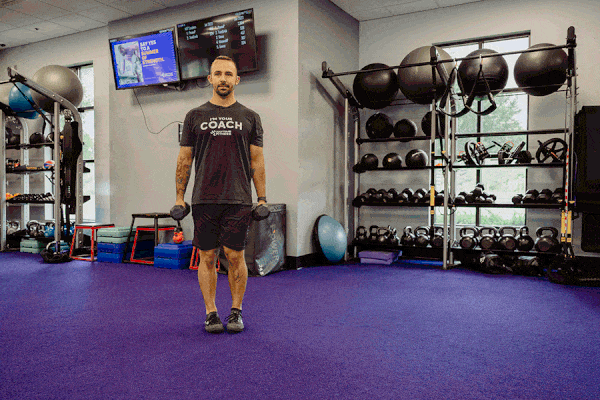
How to:
- Stand upright with your feet hip-width apart, holding the dumbbells at your sides, with your arms straight and shoulder blades back.
- Take a big step forward and to the side with your left leg, lowering your body down toward the floor and leaning your torso slightly forward. You should aim to form a 90-degree angle with your left knee, and your right foot should stay flat on the ground.
- Push down on the heel of your left foot, and return your left leg to the starting position.
- Complete all reps on one side before switching to your right leg.
Push Pull
In order to do this movement, you’ll need to have access to a cable pulley system or be able to safely anchor two resistance bands across from each other. This will target your upper body muscles, your lower back, glutes, and hamstrings.
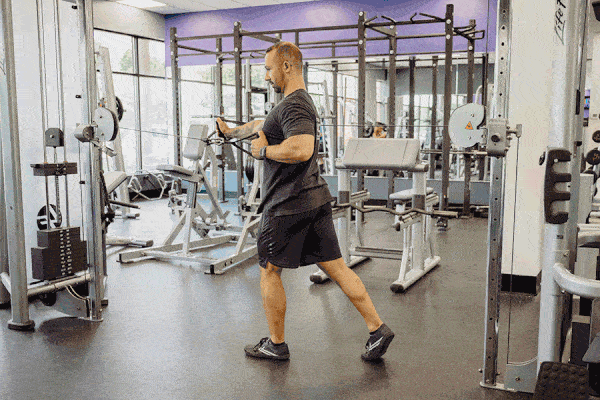
How to:
- Stand upright holding one handle with your arm straight out in front and the other at your shoulder with your elbow bent. Your right foot will be resting up on your ball/toes, and you should have a slight bend in both knees.
- If your right leg is back, you will press your right hand forward, as you simultaneously pull your left hand to your chest. Pull your right hand back, and push your left hand back in front; this is two reps.
- Press and pull in a straight line from your shoulders.
- Complete all reps each way before switching sides so that your left leg is back.
Foot Up Split Squat
Split squats are commonly used in lower-body workouts, but we’re changing it up! In order to do this exercise, you will need a step, bench, or box.
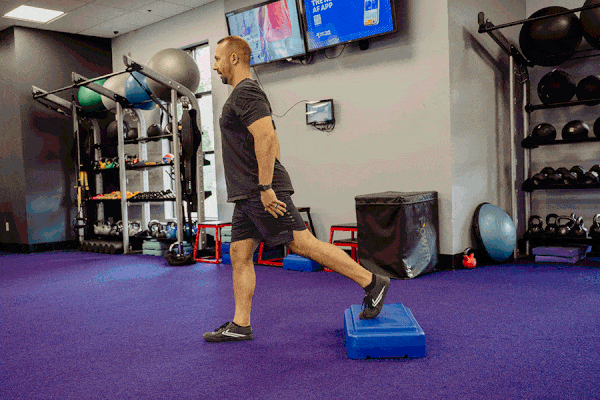
How to:
- Stand upright with the toes of your right foot on a box behind you and your arms by your sides.
- Lower your body toward the floor, bending at your hips and knees and leaning your torso slightly forward. Note: If your left knee extends beyond the toes of your left foot when squatting, or if your right knee touches the ground, step your foot further away from the box.
- Push off your front foot to return to the starting position.
- Complete all reps with the same foot on the box before switching to the other side.
Alternating Step-Ups
This move combines strength, endurance, and coordination all in one. You’ll need a step, bench, or box.
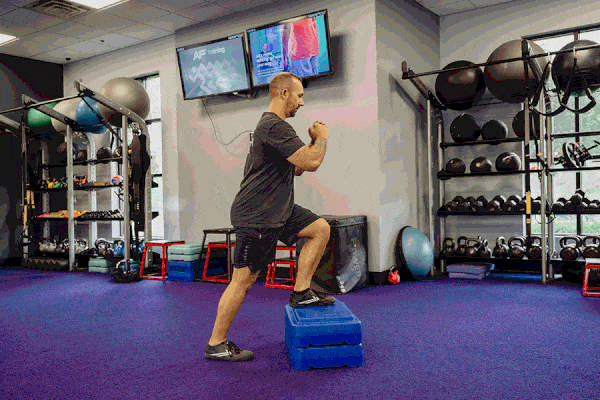
How to:
- Stand upright with your left leg on a box and your arms at your sides. There should be little to no bend in your right knee.
- Push off the top foot and drive up with your arms, jump up off the step, and switch your feet in the air.
- Land with your right foot on the step; your left leg should be on the ground.
- Do the same with your left leg to complete one rep.
Crossbody Raise
This exercise will target your shoulders while working a few other back muscles, including the traps and latissimus dorsi, which is one of the largest muscles in your back. For this, you’ll need a cable machine or resistance bands.
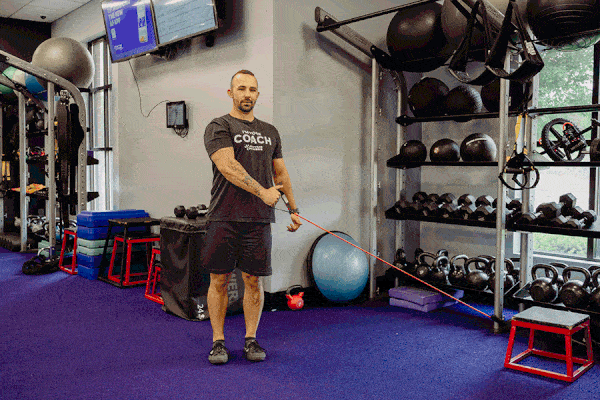
How to:
- Stand upright with your feet shoulder-width apart, and hold the handle in your left hand at your right hip.
- Pull the handle diagonally across your body until you can’t pull anymore. Push the handle to the sky to extend your arm. Slowly lower the handle back to the starting position.
- Complete all reps on one side before switching to the other side. Be sure to keep your shoulders back and your shoulder blades engaged for maximum results.
Calf Raise
This is another common exercise found in leg workouts, and it can be done on a step or box. If you’re uncomfortable or can’t quite keep your balance, this can also be done from the ground. To make the move more challenging, try holding a dumbbell, kettlebell, plate, or other weight in each hand.
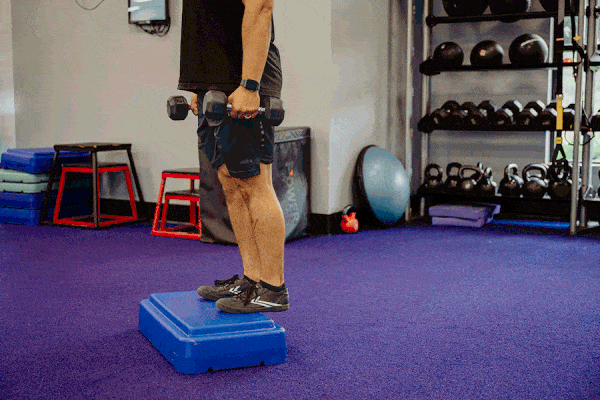
How to:
- Stand on your toes on the edge of a step with your feet hip-width apart. For more stability, place your feet shoulder-width apart. If using dumbbells, hold them down at your sides. Roll your shoulders back and pinch your shoulder blades to keep good posture.
- Lower your heels down as far as you can.
- Raise your heels coming up onto your toes again as high as you can.
Lo-Hi Chop
Get ready to blast your core muscles with this move! While we recommend using a cable machine or resistance band, this can also be performed with a dumbbell.
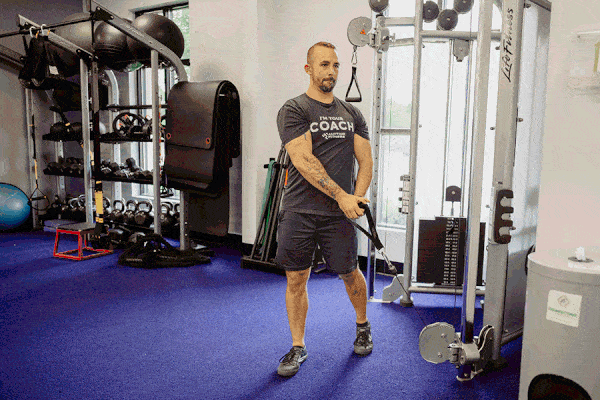
How to:
- Stand upright facing to one side, holding a handle in both hands at hip level with your arms straight. Place your feet shoulder-width apart (or hip-width if that’s more comfortable).
- Without bending your arms, twist from your torso and pull the cable from the side of your right leg across your body to your opposite shoulder. Move through your hips and shoulders, not your arms.
- Try to pinch your shoulder blades the entire movement to engage your back muscles, like your latissimus dorsi.
- Complete all reps on one side before switching to the other side.
Rear Delt Fly
This movement is commonly found in back workouts and can help you sculpt your upper back muscles, shoulders, and even your erector spinae (muscles around your spine). If you’re someone who doesn’t like pull-ups, or you don’t have access to a bar for pull-ups, then this is a great alternative. You’ll need dumbbells or plates.
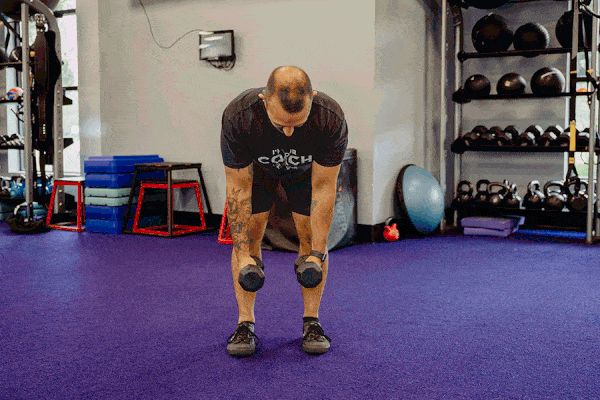
How to:
- Stand with your feet hip-width apart. Bend over at the waist, holding the dumbbells with your arms straight and palms facing in.
- Raise the dumbbells up and outward to shoulder height, keeping your back flat. Pinch your shoulder blades here for maximum results.
- Bend your elbows slightly as you lift, if necessary.
Wrist Flexion
Forearms are common muscles that people forget to work out, and they’re important! For this movement, you’ll need a bench or chair and a bar of some kind or dumbbells.
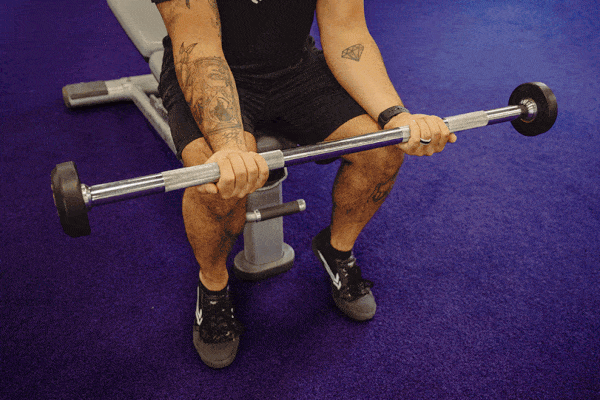
How to:
- Sit with your forearms on your thighs, holding a barbell out in front of your knees with your palms up and your wrists extended. Drop the bar into your fingertips, so that your wrists are fully extended.
- Flexing at the wrists, raise the barbell up as high as possible, and then return to the starting position.
Reverse Extension
Get ready to work your glutes, hamstrings, and lower back. This move is a great low-impact option from those who suffer from lower back pain, but still want to do back workouts. Plus, it requires virtually no equipment — just a bench.
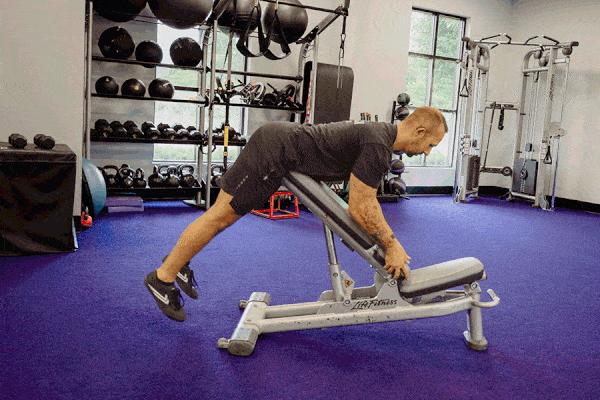
How to:
- Lie face-down on a bench, hanging your lower body off the bench with your toes touching the ground.
- Raise your lower body up until your whole body is straight. Keep your legs straight and in sync the entire time. Hold onto the top of the bench if needed.
- Lower your legs back down to the starting position.
There you go! You crushed a conditioning workout. Well done!
Combine the strength- and endurance-building benefits of a full-body conditioning workout with the energy of a team of people — and the expertise of an AF Coach — to maximize your results. Find group training sessions near you.
